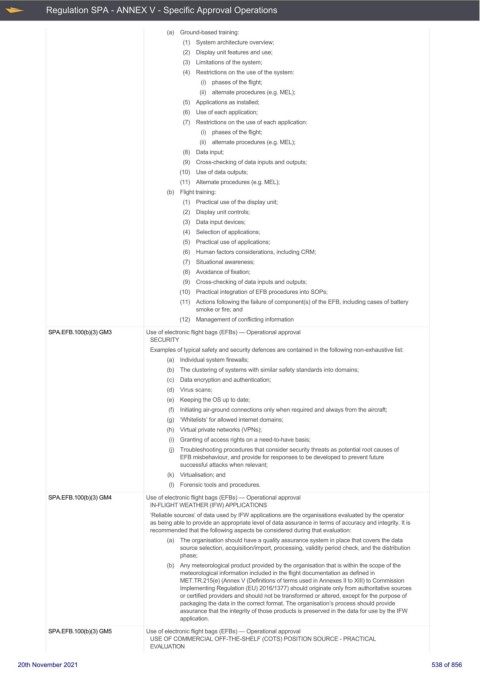Page 538 - UK Air Operations Regulations (Consolidated) 201121
P. 538
~
~ Regulation SPA - ANNEX V - Specific Approval Operations Centrik
(a) Ground-based training:
(1) System architecture overview;
(2) Display unit features and use;
(3) Limitations of the system;
(4) Restrictions on the use of the system:
(i) phases of the flight;
(ii) alternate procedures (e.g. MEL);
(5) Applications as installed;
(6) Use of each application;
(7) Restrictions on the use of each application:
(i) phases of the flight;
(ii) alternate procedures (e.g. MEL);
(8) Data input;
(9) Cross-checking of data inputs and outputs;
(10) Use of data outputs;
(11) Alternate procedures (e.g. MEL);
(b) Flight training:
(1) Practical use of the display unit;
(2) Display unit controls;
(3) Data input devices;
(4) Selection of applications;
(5) Practical use of applications;
(6) Human factors considerations, including CRM;
(7) Situational awareness;
(8) Avoidance of fixation;
(9) Cross-checking of data inputs and outputs;
(10) Practical integration of EFB procedures into SOPs;
(11) Actions following the failure of component(s) of the EFB, including cases of battery
smoke or fire; and
(12) Management of conflicting information
SPA.EFB.100(b)(3) GM3 Use of electronic flight bags (EFBs) — Operational approval
SECURITY
Examples of typical safety and security defences are contained in the following non-exhaustive list:
(a) Individual system firewalls;
(b) The clustering of systems with similar safety standards into domains;
(c) Data encryption and authentication;
(d) Virus scans;
(e) Keeping the OS up to date;
(f) Initiating air-ground connections only when required and always from the aircraft;
(g) ‘Whitelists’ for allowed internet domains;
(h) Virtual private networks (VPNs);
(i) Granting of access rights on a need-to-have basis;
(j) Troubleshooting procedures that consider security threats as potential root causes of
EFB misbehaviour, and provide for responses to be developed to prevent future
successful attacks when relevant;
(k) Virtualisation; and
(l) Forensic tools and procedures.
SPA.EFB.100(b)(3) GM4 Use of electronic flight bags (EFBs) — Operational approval
IN-FLIGHT WEATHER (IFW) APPLICATIONS
‘Reliable sources’ of data used by IFW applications are the organisations evaluated by the operator
as being able to provide an appropriate level of data assurance in terms of accuracy and integrity. It is
recommended that the following aspects be considered during that evaluation:
(a) The organisation should have a quality assurance system in place that covers the data
source selection, acquisition/import, processing, validity period check, and the distribution
phase;
(b) Any meteorological product provided by the organisation that is within the scope of the
meteorological information included in the flight documentation as defined in
MET.TR.215(e) (Annex V (Definitions of terms used in Annexes II to XIII) to Commission
Implementing Regulation (EU) 2016/1377) should originate only from authoritative sources
or certified providers and should not be transformed or altered, except for the purpose of
packaging the data in the correct format. The organisation’s process should provide
assurance that the integrity of those products is preserved in the data for use by the IFW
application.
SPA.EFB.100(b)(3) GM5 Use of electronic flight bags (EFBs) — Operational approval
USE OF COMMERCIAL OFF-THE-SHELF (COTS) POSITION SOURCE - PRACTICAL
EVALUATION
20th November 2021 538 of 856

